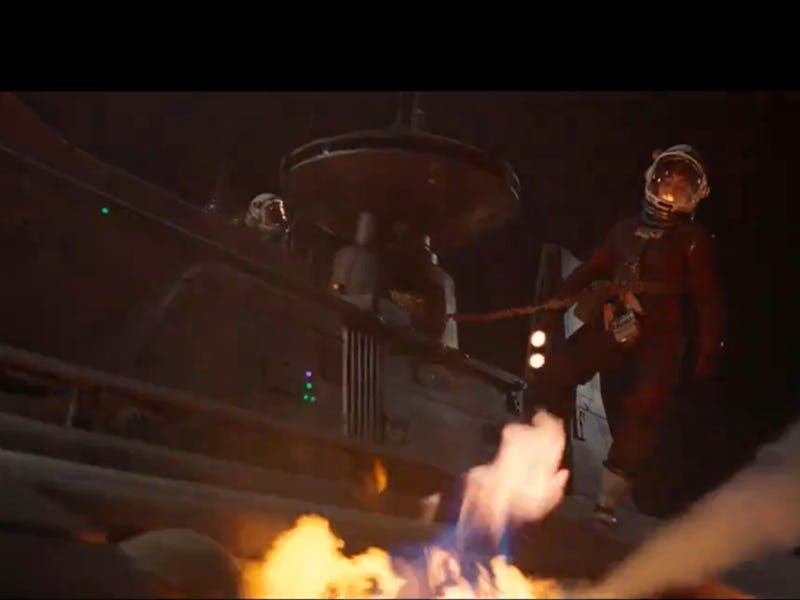The Acolyte Got Fire In Space Ridiculously Wrong — In Real Life, It’s So Much Weirder
We get it. Star Wars isn't science fiction. But still.

We need to talk about that scene in the new Star Wars show, The Acolyte. Yes, the one with the flickering, crackling fire in space.
Star Wars has never been noted for its scrupulous accuracy; that’s not really the point of the series. It’s space opera, not science fiction. But one scene in an episode of the new show Acolyte — which follows Jedi padawan Osha and her adventures on the titular spaceship — has stirred up quite a disturbance in the Force.
Osha, whose name is ironically perfect for this scene, suits up for a spacewalk to fight a fire out on the Acolyte’s hull, but the fire — on the exterior of the ship, with no atmosphere and in the microgravity of space — is startlingly ordinary. Flames dance and flicker, accompanied by a menacing crackling noise.
There’s so much wrong with this picture, even by the gleefully fast-and-loose-with-physics standards of the franchise.
This is not how fire in space works.
How to Make a Fire in Space
Oxygen itself isn’t flammable, but it’s a vital ingredient in the chain of chemical reactions that produces fire. If Earth had just a little less oxygen in its atmosphere, humans would never have been able to start fires at will, so most of our modern technology wouldn’t exist. You definitely can’t start a fire in the vacuum of space.
However, for the sake of not spoiling all the fun, let’s assume that the stuff blasting out of the pressure valve next to the fire contains some oxygen, or that there’s oxygen leaking from somewhere in the system very near the fire. Burning requires oxygen, but in microgravity, it requires less oxygen than it does here on Earth. Acolyte’s exterior mechanical bits could keep burning as long as there’s fuel and oxygen being blasted into space nearby.
Another thing you can’t have in a vacuum is sound, like the crackling and popping of Acolyte’s fire. What we perceive as sound is actually waves of pressure passing through the air, and you need a certain density of air to make that happen. Even if there’s enough oxygen escaping from the valve to keep the fire going, there’s surely not enough to transmit sound.
On the left is a familiar sight: a candle flame in normal gravity. On the right is a candle flame in microgravity.
Acolyte’s Fire Looks All Wrong
Here on Earth, or anywhere else with gravity, hot air rises because it’s less dense, and cold air sinks because it’s denser. In the center of a flame, hot air rises and expands; cooler air sinks, and fresh air rushes in at the base of the fire, keeping it fueled with oxygen. That process sculpts the flame into the familiar spiky shapes that dance in fireplaces and campfires. It also causes the flames to flicker.
But in microgravity, without gravity to make hot air rise and cool air fall, that whole process doesn’t happen. Fires aboard the International Space Station tend to be more rounded and fluid-looking, and they stick pretty close to the surface of whatever’s burning. The flames Osha encountered should have looked more like a slightly domed puddle if its fuel was somehow stuck to the surface of the ship. If what was burning was actually something escaping from a line or valve, then she might have had floating blobs of fire to contend with.
That would have made for a much more dramatic scene — not to mention a more accurate one.
This is a flame from an experiment aboard ISS.
How Do We Know What Fire in Space is Like?
Astronauts aboard the International Space Station have been playing with fire for years. A special chamber on the ISS provides a safe, contained area to start small fires and observe how they behave — and test new methods for preventing them and putting them out. Over the last eight years, NASA has also set much larger fires in the empty cargo holds of uncrewed Cygnus cargo vessels, returning to Earth after dropping off supplies at ISS.
Before the ISS, U.S. astronaut Jerry Linenger and his Russian and ESA crew mates had to fight a real-life space fire aboard the aging Russian space station Mir in 1997. A solid-fuel oxygen generator caught fire, and the six crew members came perilously close to not surviving the incident.
Those experiences and experiments have helped researchers learn how fire behaves — and how a deadly fire might spread — in microgravity, and how it responds to different levels of oxygen and cabin pressure. Their goal is to select less flammable, safer materials for spacecraft cabins and develop better firefighting tools for astronauts.
A side effect of all that research is that we know perfectly well that Acolyte’s Osha should be fighting an eerily silent, unearthly blob of fire. Which would have been extremely cool to watch.